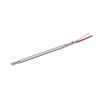Solinst Model 800 Low Pressure Packers
Features
- Designed for isolating discrete zones for short-term monitoring
- Ideal for use with Solinst Bladder Pumps or Double Valve Pumps
- Inflated using a hand pump up to 50 psi
- Free ground shipping
- Expedited repair and warranty service
- Lifetime technical support
- More
Overview
The Solinst Model 800 Low Pressure Packers inflate with a hand pump and are available in 1.8" and 3.9" (46 mm and 99 mm) diameters. Typical inflation pressures for the 1.8" (46 mm) packers are from 20–40 psi (140–275 kPa) above hydrostatic pressure, and from 20–30 psi (140–205 kPa) for the 3.9" (99 mm) packers.
Design
The Packers utilize a gland of black carbon reinforced rubber (BCR) on a Sch 80 PVC body. They are lowered on a support cable or a rigid PVC drop pipe. The inflation line is standard LDPE tubing and connects to the packers using a simple push fitting.
Applications
Primarily for short-term use in 2" and 4" (51 mm and 102 mm) monitoring wells, they can also be used in smooth boreholes and wells with 1.9–5" (48–127 mm) inside diameters. If a rigid drop tube is not required for the application, it is recommended that a safety line be attached to the eyebolt provided. The Solinst Model 103 Tag Line provides a convenient, graduated support cable that can be used for this purpose, as well as for measuring placement depth.
Use
Solinst packers are ideal for use with Solinst Bladder Pumps or Double Valve Pumps, which can be easily attached above the packers. The water inlet can be below a single packer, or through perforated pipe fitted between straddle packers. For hydraulic conductivity testing, Solinst Leveloggers can also be suspended, either below or between packers, from the eyebolt on the bottom of the packer.
In The News
New map shows significant groundwater depletion in Central California
Groundwater level data collected by a Central California county shows significant drops during the past 12 years, according to a San Luis Obispo Tribune article. Data shows that groundwater has dropped by a minimum of 70 feet from 1997 to 2009 in the Paso Robles area of Central California. In the past four years the areas of most significant decline have expanded north and south. Drought and agricultural withdrawals are the likely culprits for the groundwater decline. Some advocates are calling for more responsible water use by vineyards in the area, while farmers note that the recent drought did not help the situation.
Read MoreWildfire Prevention in the Sierra Nevada Region with the Yuba Watershed Institute
Though recent wildfires have sparked new conversations about wildfire management and response, groups like the Yuba Watershed Institute have been monitoring the forests and water resources of the Sierra Nevada region for decades, managing approximately 5,000 acres of land with the Bureau of Land Management (BLM) and about 7,000 acres in private land partnerships. The goal of the Institute is to work with local communities and land agencies to improve watershed and forestry management through informed practices and public outreach. The goals of the Yuba Watershed Institute are three-fold: Improve the ability of fire suppression agencies like the California Department of Forestry and Fire Protection ( CAL FIRE ) and the US Forest Service.
Read MoreWave Sensors Integration with NexSens Buoys: A Cutting-Edge Solution for Wave Measurment
Real-time wave data supports accurate weather prediction, safe and efficient maritime operations, and provides valuable safety and operating condition information for recreation and commercial fishing. Understanding wave dynamics also helps with the design of protective coastal structures like seawalls, breakwaters, and jetties. It also supports better prediction of their impact on sediment transport and coastal geomorphology. Wave data is a key factor in qualifying and designing offshore wind farms and harnessing kinetic energy for electrical generation. It helps with the understanding of ocean-atmosphere interactions and contributes to studies of sea-level rise and climate change impacts.
Read More



























